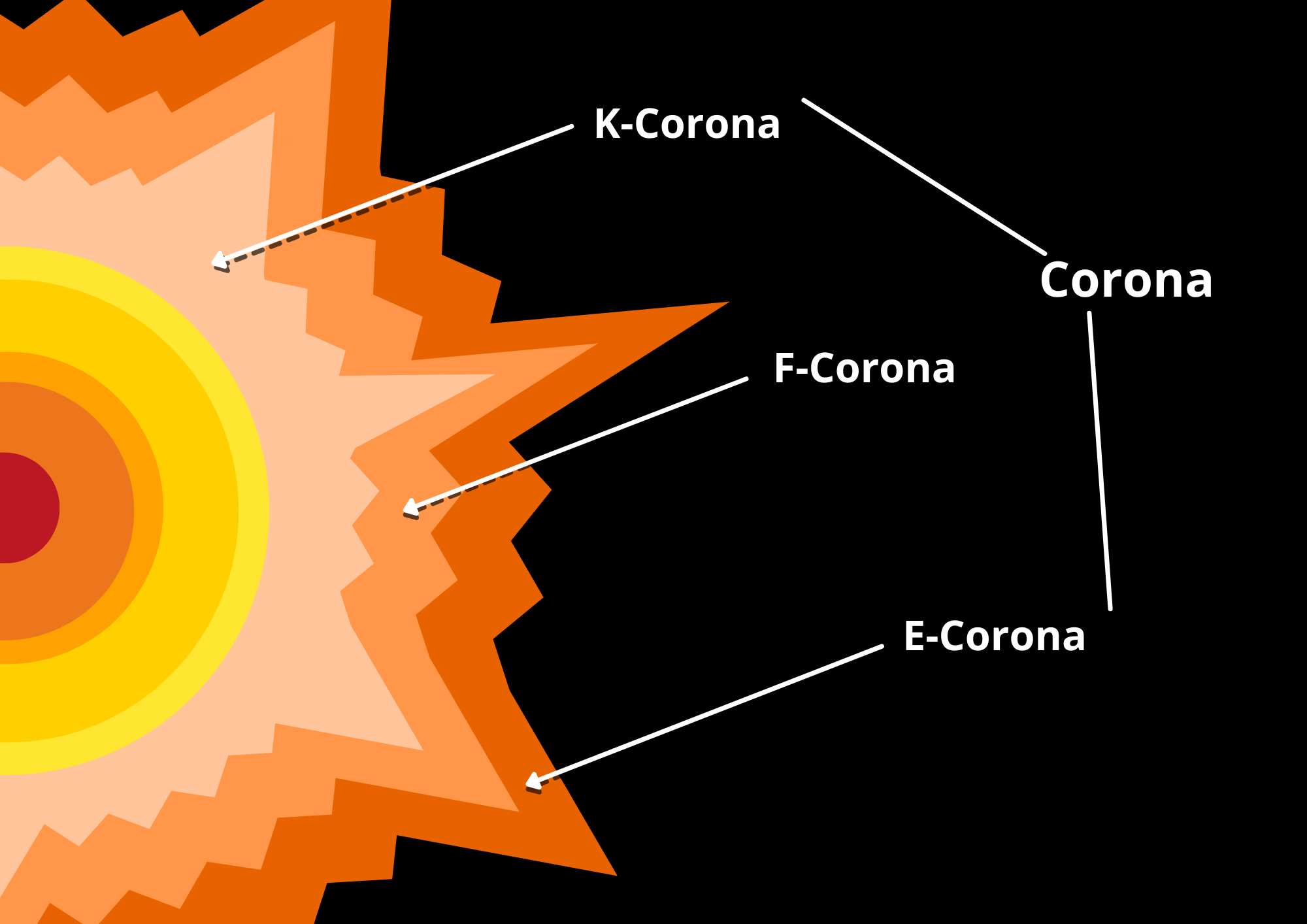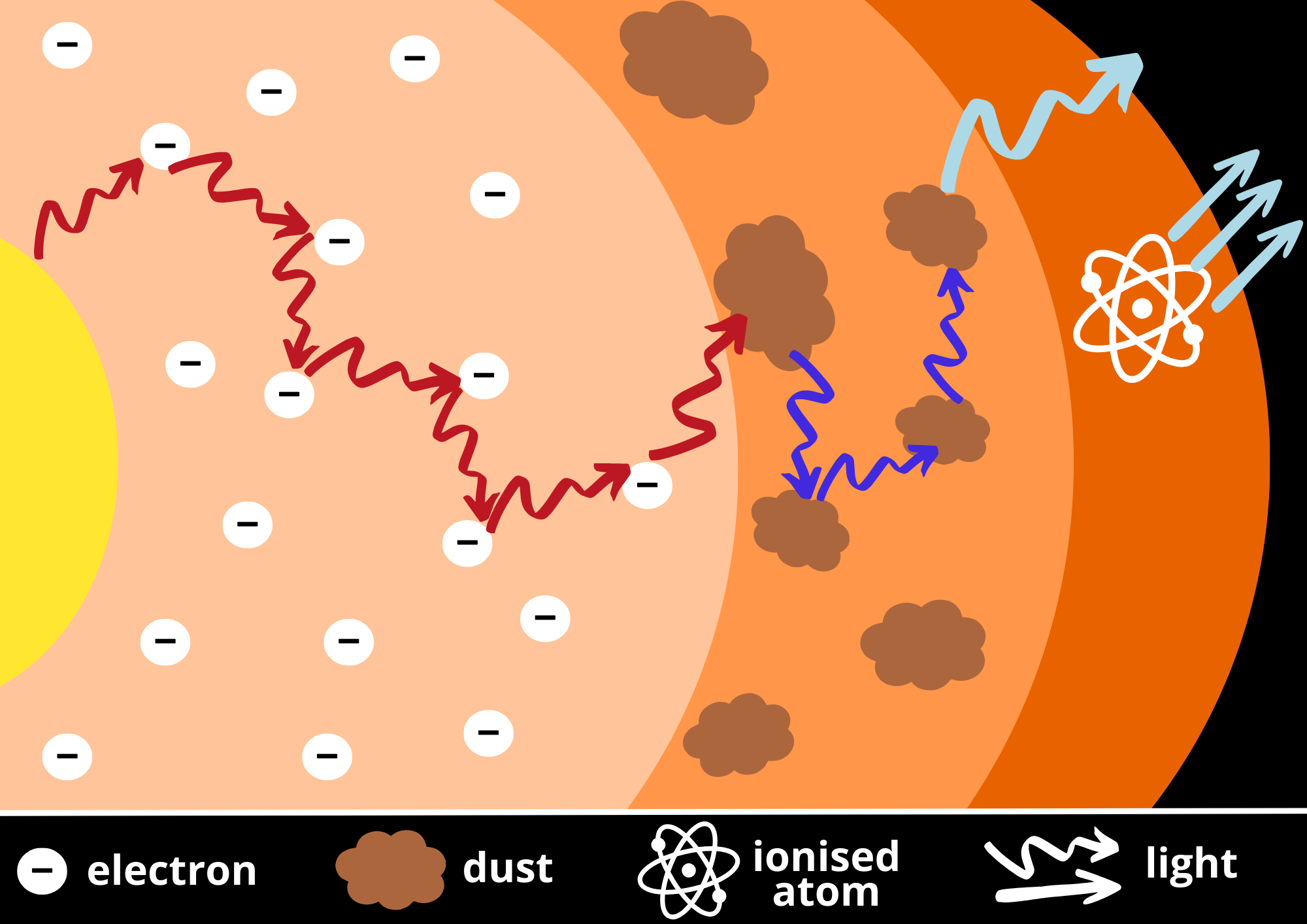Featured Image Credits: Lick Observatory Records: Glass negatives. UA 36 Ser.6. University Archives, University Library, University of California, Santa Cruz.
Introduction
The corona is the irregularly shaped outer layer of the solar atmosphere which extends over a million kilometres out into space.
This layer of plasma is a lot more sparsely packed compared to other parts of the solar atmosphere – meaning it is a lot dimmer than the Sun’s surface. As a result, we can only really see the corona’s white light during a total solar eclipse.
The corona is also surprisingly extremely hot compared to the rest of the solar atmosphere. This is unexpected because of the relatively low density in the corona when compared to other layers of the Sun. Additionally, the Sun’s core is the hottest part, and the layers get cooler as you go further out from the centre. Therefore, you would expect the corona to be the coolest part of the Sun. Instead, the corona can reach temperatures of up to 2 million degrees Kelvin. Scientists have called this the ‘coronal heating problem’ and work is currently being done to figure out why the corona is so hot.
You can learn more about this kind of research at the University of St Andrews here.

Relevance of solar eclipses
Historically, before the development of equipment like specialised telescopes, the only way scientists could study the corona was by viewing total solar eclipses. When the moon blocks out the rest of the Sun’s brighter light, we can very clearly see the dimmer light of the corona. It’s thanks to solar eclipses that we even know so much about the corona and therefore understand more about the Sun at present. Although we now have equipment such as coronagraphs that can be used to study the Sun, solar eclipses are still important events that are useful today.
Now, scientists are particularly interested in studying the corona to try to understand things like coronal mass ejections (abbreviated as CMEs – eruptions of charged particles from the corona) and the solar wind (continuous streams of charged particles from the Sun). This is an active area of research because geomagnetic storms induced by CMEs interact with the Earth’s magnetic field. Although this interaction leads to spectacular events such as aurorae, it can also be harmful for our space-based technology. In severe cases, we may even experience power outages and radio communication blackouts.
Processes in each layer
The Sun’s corona layer can be broken up into three more main layers. The main processes in each layer are described in the following table, as well as visualised in the diagram to the right.

Structure of the Sun's Corona (Fact Table)
| Layer | Origin of the Layer's Name | Description |
|---|---|---|
| K-Corona | ‘K’ for ‘Kontinuum’ (German for ‘continuum’), or alternatively for ‘Kontinuierlich’ (German for ‘continuous’) | This is the innermost layer of the corona, caused by light from the photosphere being scattered by rapidly moving electrons. Like its name suggests, the spectrum of light from this part of the corona appears continuous. The extremely high temperatures here give electrons enough kinetic energy to move so fast that the wavelengths of light from the photosphere get Doppler-shifted by a large amount. These shifts end up effectively cancelling out any absorption lines from the photospheric Fraunhofer spectrum. The K-corona’s light dominates up to about 1.4 million kilometres from the centre of the Sun, and becomes much fainter beyond. |
| F-Corona | ‘F’ for ‘Fraunhofer’, from ‘Fraunhofer lines’ | The F-corona is the part of the corona caused by dust particles scattering light from the photosphere. It is brightest part of the corona from around 1.4 million kilometres onwards from the centre of the Sun. We can see the light from the F-corona because the light scattered contains the Fraunhofer absorption lines (hence its name). In other words, the light has the same wavelengths as the regular sunlight seen from Earth (light emitted from the photosphere). Sometimes we can see light from the F-corona as ‘zodiacal light’ much further away from the Sun. |
| E-Corona | E’ for ‘emission’ | Light from this layer is from the emission of radiation from highly ionised atoms in the hot plasma. The emission lines are known as the ‘forbidden lines’ of elements such as carbon and iron. The radiation from this part of corona is very weak, so the E-corona’s light is a lot fainter than the light from other coronal layers. |
How it is studied
Scientists have studied the Sun, and particularly its corona, through a variety of methods and using different kinds of equipment. For example, scientists can use something called a ‘coronagraph’ to photograph and investigate the corona without having to wait for an eclipse to take place. Another example is the ‘spectroheliograph’ – which can help us build 3D models of the Sun by photographing the Sun at different wavelengths.
Other methods of studying the Sun include those using large scale computer simulations that solve a system of equations called the ‘magnetohydrodynamics (MHD) equations’, which combine Maxwell’s laws of electromagnetism with the laws of fluid dynamics to model the behaviour of the Solar corona.
You can read more about the equipment and methods used to study the Sun in the ‘Technology’ tab in the menu.
Glossary
| Term | Definition |
|---|---|
| Absorption lines | Dark lines representing specific wavelengths of electromagnetic radiation that a source absorbs. |
| Doppler-shift | An apparent change in the wavelength and frequency of waves, due to a change in the distance between the source of the waves and the observer/receiver of the waves. |
| Emission lines | Bright lines of specific wavelengths of electromagnetic radiation emitted from a source. |
| Fraunhofer lines | Dark absorption lines representing the wavelengths of light absorbed in the Sun’s photosphere. |
| Ion/Ionisation | An ion is an atom of an element that has a positive or negative charge, from either losing or gaining one or more electrons. Ionisation is the process of an atom becoming an ion. |
| Kinetic energy | A form of energy due to an object in motion. |
| Spectrum | A group of waves organised in order according to wavelength or frequency. Emission or absorption spectra (groups of lines at specific wavelengths) are useful for identifying elements. |
| Wavelength | The length of a single wave, measured between two wave peaks. |
| Zodiacal light | A faint band of light in the shape of a long cone, sometimes visible from the night sky during twilight or dawn. This is light from the Sun that gets reflected by dust in space. |
Further reading
E corona (no date) Oxford Reference, [Accessed: 22 June 2023].
F corona (no date) Oxford Reference, [Accessed: 22 June 2023].
Golub, L. and Pasachoff, J.M. (2010) ‘1’, in The solar corona. New York: Cambridge University Press.
K corona (no date) Oxford Reference. Available at, [Accessed: 22 June 2023].
Pasachoff, J.M. (1973) ‘The solar corona’, Scientific American, 229(4), pp. 68–79. doi:10.1038/scientificamerican1073-68.
The origin of the Corona’s light (no date) NASA, [Accessed: 22 June 2023].